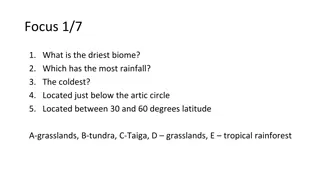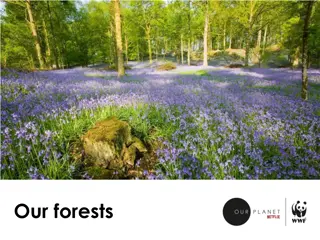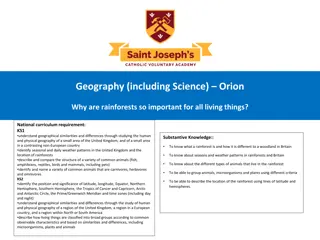Exploring the Fascinating World of Tropical Rainforests
Tropical rainforests, found near the equator, boast incredible biodiversity with over half of the planet's plant and animal species residing there. These lush forests, characterized by uniform temperatures and consistent rainfall, play a vital role in producing oxygen for Earth. From the towering canopy to the diverse flora and fauna, rainforests showcase a myriad of unique adaptations and thriving ecosystems.
Download Presentation

Please find below an Image/Link to download the presentation.
The content on the website is provided AS IS for your information and personal use only. It may not be sold, licensed, or shared on other websites without obtaining consent from the author. Download presentation by click this link. If you encounter any issues during the download, it is possible that the publisher has removed the file from their server.
E N D
Presentation Transcript
Tropical forests are characterized by the greatest diversity of species. They occur near the equator. Because the equator is evenly heated by the sun, the average temperatures of the three warmest and three coldest months do not differ by more than 5 degrees. The amount of rainfall is also about the same all year round. Average rainfall in the rainforest is around 70-80 inches.
More than half of all the world's plant and animal species live in tropical rain forests. Tropical rainforests produce 40% of Earth's oxygen. Seventy percent of the plants in the rainforest are trees. There are four main layers of plants in the rainforest. The top layer is called the canopy, it blocks most light from the rainforest floor.
The tallest trees have no side branches because there is little light under the canopy. Many plants have brightly colored flowers and strong, sweetly scented fruit to attract insects and animals. The leaves of rainforest trees have adapted to cope with the large amount of rain. The leaves are big, thick and waxy, and have 'drip tips' to let the rain drain off quickly. Some trees have roots in the air to catch moisture.
Some plants grow on the branches of the tall trees so that they are closer to the sunlight and to absorb the trees nutritents. Most trees have smooth bark to keep other plants from climbing or living on them. There are many carnivorous plants in the rainforest. There are many types of plants that are climbing vines.
ANIMAL ADAPTATIONS Many animals are adapted to be good at climbing since there are so many trees. Many rainforest animals use camouflage and mimicry to 'disappear' in the rainforest. Some animals are poisonous, and use bright colors to warn predators to leave them alone.
Pretty Birds! Beaks, Feet, and Feathers with a special design Many birds eat nuts, and developed big strong beaks to crack open the tough shells. File:Irediparra gallinacea1.jpg Tree birds have long toes that can perch easily on branches. The Jacana has extremely long toes so it can walk on lily pads without falling through. The kingfisher has a long, spear like beak for catching fish.
Rainforest Herbivores: elephants, fruit bats, tapirs, gorillas, howler monkeys, iguanas, hummingbirds, tortoises, capybaras, leaf cutter ants, manatees, and hippopotami.
Rainforest Carnivore examples Mammals-Leopards, tigers and other big cats. Reptiles-Crocodiles and caimans, anacondas and other snakes Birds-harpy eagles
Rainforest Omnivores Monkeys, marmosets, chimpanzees, bears, coatimundi, kinkajous, and lemurs
Scavengers: vultures, ants, millipedes Decomposers: Fungi, worms, bacteria, termites, cockroaches,























